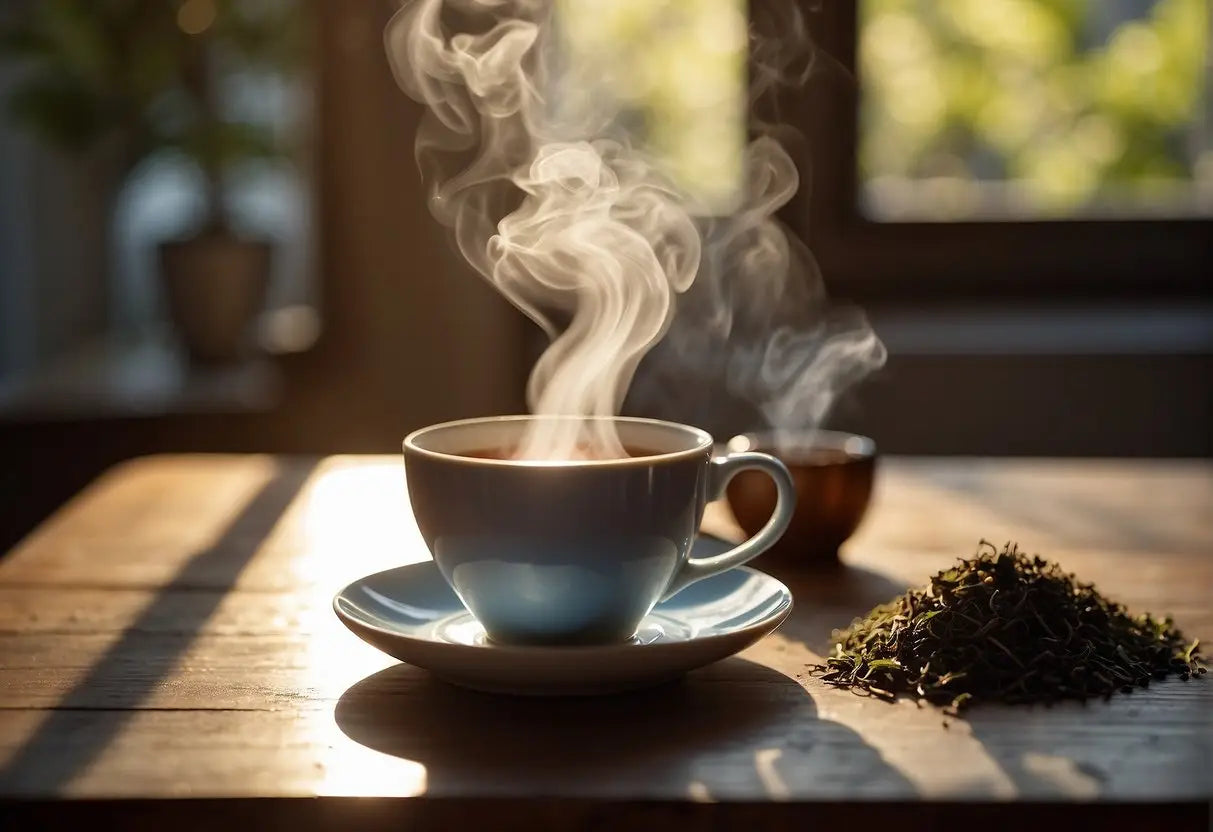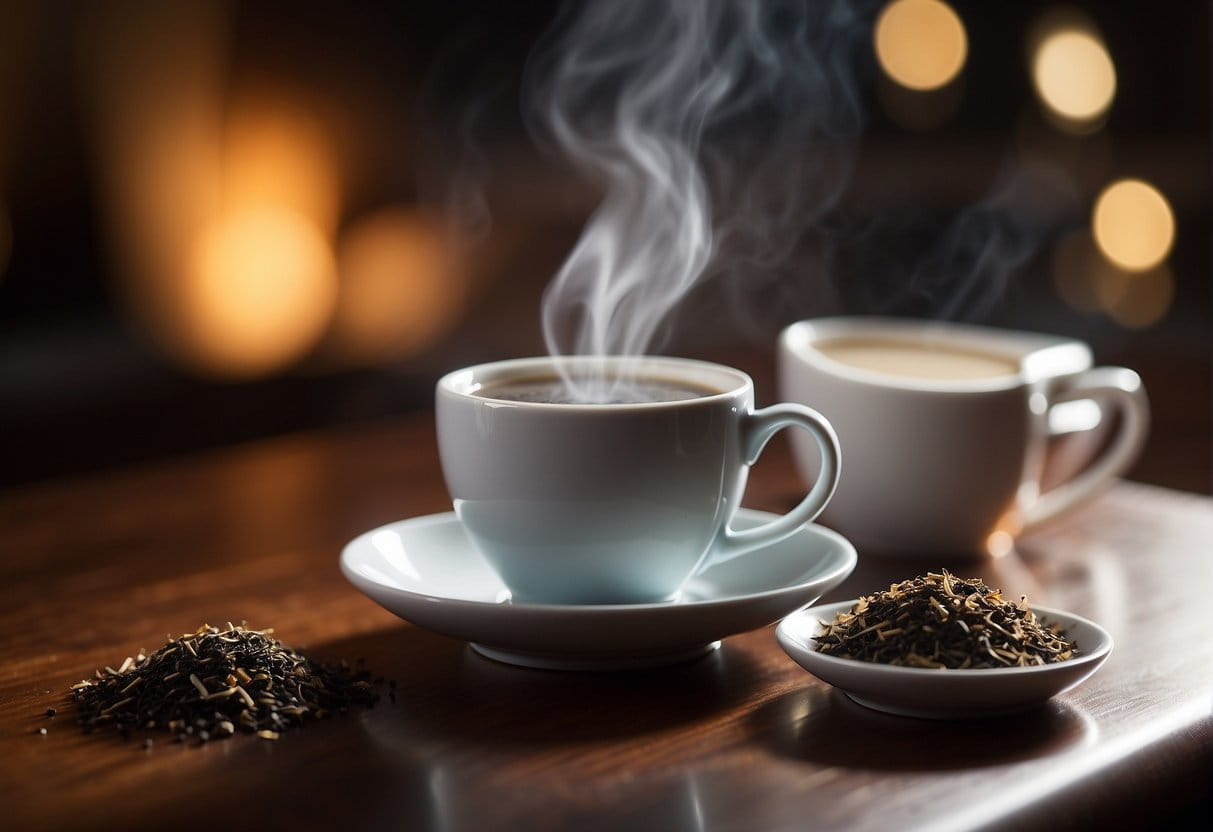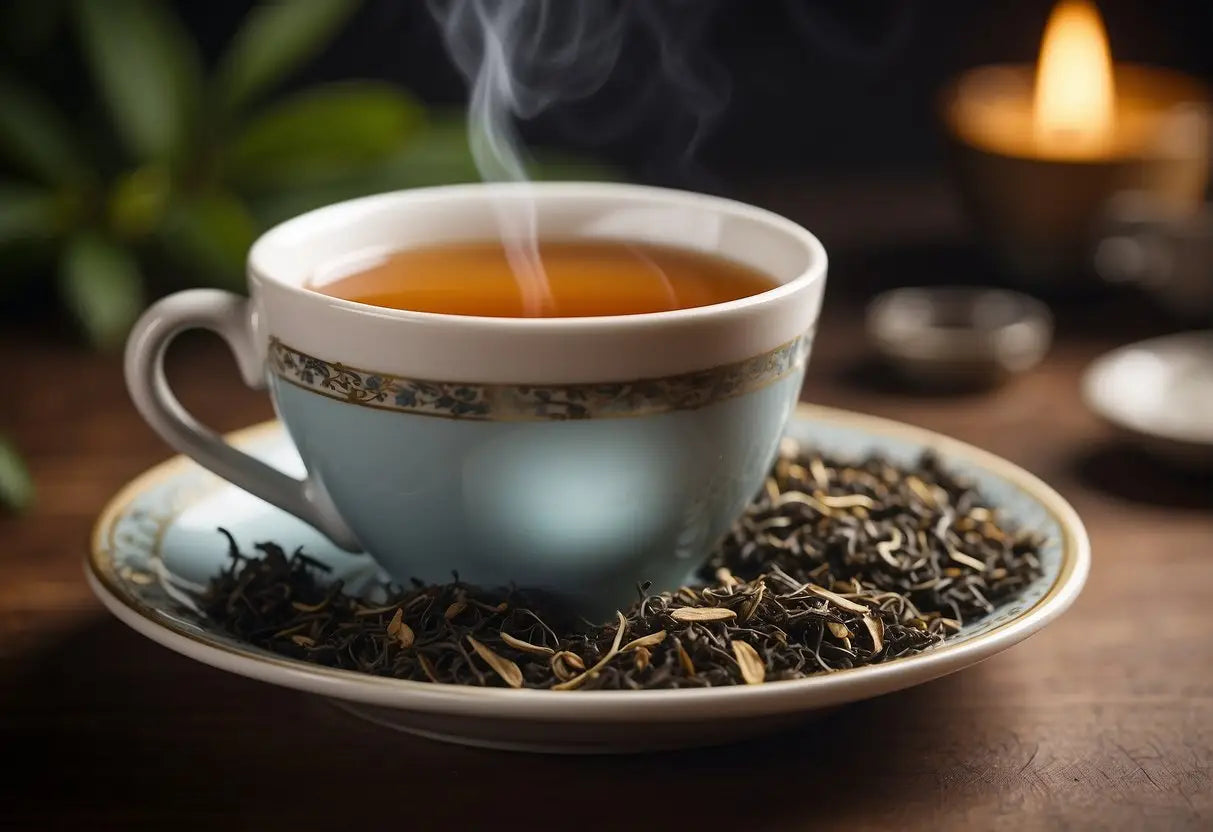How Much Caffeine is in Earl Grey Tea
Shop our Pu Erh Tea collections!
Earl Grey tea, a renowned flavored tea with distinctive hints of bergamot oil, is a popular choice for its refreshing taste. Your cup of Earl Grey will typically contain caffeine, as it is derived from black tea leaves. The average amount of caffeine in an 8-ounce (240-milliliter) serving of Earl Grey is between 40 and 120 milligrams. However, the caffeine content can vary depending on several factors, such as:
- Brewing time: The longer you brew the tea, the more caffeine it will likely contain.
- Tea leaf quality: Higher quality leaves often have more caffeine.
- Tea leaf cut: Finer cuts of tea leaves expose more surface area and typically infuse more caffeine into the water.
It's important for you to consider these factors if you are monitoring your caffeine intake. Here's a quick reference:
Bestsellers
| Brewing Time | Estimated Caffeine Content |
|---|---|
| 1 minute | 15-40 mg |
| 3 minutes | 20-70 mg |
| 5 minutes | 25-120 mg |
Remember, you can adjust the tea's caffeine content by changing the brewing time. For those sensitive to caffeine or wishing to reduce intake, opt for shorter brewing times or consider decaffeinated Earl Grey tea variants which usually contain around 1 to 5 milligrams of caffeine per serving. Keep in mind that individual sensitivity to caffeine varies, so it's prudent to consume Earl Grey in moderation.
Discover our best-selling raw Pu Erh tea and elevate your tea experience today!
Factors Affecting Caffeine Levels

Check out our Sheng pu erh tea collection and Ripe pu erh tea collection.
The caffeine content in your cup of Earl Grey tea can vary depending on several specific factors related to tea preparation and processing.
Tea Leaves and Processing
The type of Earl Grey tea you choose, whether it's loose leaf or bagged and the degree of processing they’ve undergone, will significantly impact the caffeine content. For example:
- Loose Leaf Tea: Contains varying amounts of caffeine depending on leaf size and cut. Larger, whole leaves often result in less caffeine when steeped.
- Processing: Black tea leaves used in Earl Grey are oxidized, which can affect caffeine concentrations. More oxidized teas usually contain more caffeine than less oxidized teas.
Brewing Time
Your brewing time directly affects the amount of caffeine in your tea:
- Shorter Brewing Time: 1-2 minutes can yield approximately 14-40 mg of caffeine.
- Longer Brewing Time: Extending this to 3-5 minutes can increase the caffeine content to between 40-70 mg.
Water Temperature
The temperature of the water you use to brew tea is another critical factor:
- Hotter Water: Can extract caffeine more efficiently, leading to a higher caffeine level in your tea.
- Cooler Water: Slows down the extraction process, resulting in a lower caffeine content.
By adjusting these elements, you can control the caffeine level in your Earl Grey tea to suit your preferences.
Comparison with Other Teas

When you compare the caffeine content of Earl Grey tea with other types, you'll find it generally falls within the range of black teas. Each variety of tea contains caffeine in varying levels, affecting the overall stimulative effect.
Black Tea
Earl Grey is a type of flavored black tea, typically blended with oil extracted from the rind of the bergamot orange. Black tea, including Earl Grey, generally contains about 40-70 mg of caffeine per 8 oz (240 ml) serving. This makes Earl Grey similar in caffeine content to other black teas.
- Assam (Bold, malty flavor): 60-90 mg
- Darjeeling (Fruity, floral notes): 50-90 mg
| Black Tea | Caffeine Content |
|------------------|------------------|
| Earl Grey | 40-70 mg |
| Assam | 60-90 mg |
| Darjeeling | 50-90 mg |
Green Tea
Green tea is known for its lighter taste and lower caffeine content. On average, you can expect an 8 oz cup of green tea to contain roughly 20-45 mg of caffeine. Therefore, Earl Grey typically has a higher caffeine level than most green teas.
Lao Ban Zhang
- Sencha (Grassy, sweet): 20-30 mg
- Matcha (Rich, full-bodied): 35-70 mg, depending on preparation
| Green Tea | Caffeine Content |
|-----------|------------------|
| Sencha | 20-30 mg |
| Matcha | 35-70 mg |
Herbal Tea
Herbal teas, unlike true teas from the Camellia sinensis plant, typically have no caffeine unless blended with tea leaves. You can enjoy a cup of herbal tea such as chamomile, peppermint, or rooibos any time without concerning yourself with caffeine content. Earl Grey, in contrast, always contains caffeine due to its black tea base.
- Chamomile (Floral, apple-like taste): 0 mg
- Peppermint (Cooling, refreshing): 0 mg
| Herbal Tea | Caffeine Content |
|--------------|------------------|
| Chamomile | 0 mg |
| Peppermint | 0 mg |
Health Implications of Caffeine

In consuming caffeine through Earl Grey tea, you encounter both beneficial and adverse effects on your health.
Benefits
- Mental Alertness: You can enhance your cognitive function, specifically alertness, by consuming moderate amounts of caffeine, which typically ranges from 20 to 60 mg per 8 oz cup of Earl Grey tea.
- Physical Performance: Regular consumption of caffeine may improve your physical endurance, as it aids in the mobilization of fatty acids from fat tissues, potentially enhancing athletic performance.
Risks
- Sleep Disruption: Caffeine can interfere with your sleep patterns. The 20 to 60 mg in an 8 oz cup of Earl Grey tea can stay in your system for several hours and may lead to insomnia or reduced sleep quality.
- Increased Heart Rate and Blood Pressure: Excessive intake of caffeine has been linked to a temporary increase in heart rate and blood pressure, which may pose a risk if you have pre-existing cardiovascular conditions.
Possible Variations of Earl Grey

Earl Grey tea offers diverse experiences through its variations, each differing in flavor and caffeine content to fit your preference.
Traditional Earl Grey
The classic version you're familiar with gets its distinctive taste from oil of bergamot. Caffeine levels typically range between 40-120 mg per cup, depending on factors such as steeping time and tea leaf quality.
Decaffeinated Earl Grey
For a lower caffeine option, this variety provides the same bergamot flavor, but with most of the caffeine removed. Expect caffeine content to be less than 5 mg per cup.
Earl Grey Blends
- Lady Grey: A lighter variant with additional citrus peels and cornflower petals.
- French Earl Grey: Enhanced with rose petals, adding a floral note.
- Russian Earl Grey: Includes citrus peels and lemongrass, giving it a more herbal profile.
Each blend offers unique caffeine levels, but they generally stay within the range of traditional Earl Grey.
Frequently Asked Questions

When considering Earl Grey tea's caffeine content, it's important to understand how it compares to other caffeinated beverages, its suitability for evening consumption, and the impact of decaffeination. Tailoring your Earl Grey intake to your caffeine sensitivity can enhance your tea experience.
What amount of caffeine does a typical serving of Earl Grey tea contain?
A typical 8 oz (240 ml) serving of Earl Grey tea contains approximately 40-120 mg of caffeine. The range depends on factors such as the strength of the brew and the origin of the tea leaves.
How does the caffeine content in Earl Grey compare to that of coffee?
A standard cup of coffee has about 95-200 mg of caffeine. This means Earl Grey tea generally has less caffeine than coffee, often about half as much.
Can you drink Earl Grey tea before bedtime, or does its caffeine content make it unsuitable?
Given that Earl Grey contains caffeine, it may affect your ability to fall asleep. If you are sensitive to caffeine, it's advisable to avoid Earl Grey in the hours leading up to bedtime.
What are the differences in caffeine levels between regular Earl Grey tea and its decaffeinated variant?
Decaffeinated Earl Grey tea typically contains 2-10 mg of caffeine per 8 oz serving, which is significantly lower than the regular version's 40-120 mg range.
In terms of caffeine content, how does Earl Grey tea measure up against other types of teas?
Earl Grey tea often has a similar caffeine content to other black teas, but less than the caffeine in yerba mate or matcha. It generally has more caffeine than most green or white teas.
Does Twinings Earl Grey have a different caffeine content compared to other Earl Grey brands?
Twinings Earl Grey has an estimated caffeine content of about 30-48 mg per 8 oz serving, which falls within the average range for Earl Grey teas, although different brands may vary slightly.
← Older post Newer post →











